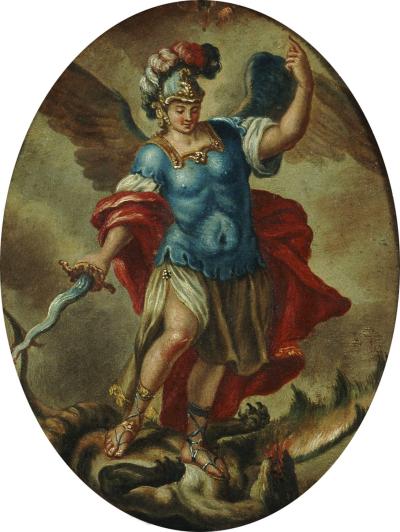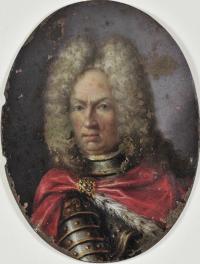Ο Αρχάγγελος Μιχαήλ
 Work Artirst Modal
Work Artirst Modal
Ο Αρχάγγελος Μιχαήλ
Δοξαράς Παναγιώτης (1662 Κουτήφαρι Μάνης - 1729 Κέρκυρα)
Σύμφωνα με την επικρατέστερη άποψη, γεννήθηκε στο Κουτήφαρι της Μάνης, όμως το 1664/1665 η οικογένειά του εγκαταστάθηκε στη Ζάκυνθο που βρισκόταν υπό ενετική κατοχή. Εκεί, στα 1685, πήρε μαθήματα αγιογραφίας κοντά στον κρητικό ζωγράφο Λέο Μόσκο. Στα πρώτα γνωστά του έργα συγκαταλέγεται η εικόνα του Χριστού ως Αρχιερέα, που φιλοτέχνησε το 1691 για την Κυρία των Αγγέλων στη Ζάκυνθο και η οποία αργότερα επιζωγραφίστηκε από το Νικόλαο Κουτούζη. Στα 1694 - 1699 έλαβε μέρος στους πολέμους της Βενετίας εναντίον των Οθωμανών, και για το λόγο αυτό τιμήθηκε με το παράσημο του Ιππότη, ενώ αργότερα του παραχωρήθηκαν και κτήματα στη Λευκάδα. Στο γύρισμα του αιώνα και έως το 1704 έζησε στην Ιταλία, όπου κατά πάσα πιθανότητα σπούδασε ζωγραφική. Κατά την επιστροφή του εγκαταστάθηκε στην ενετοκρατούμενη Καλαμάτα, όπου παρέμεινε έως το 1715, χρονιά κατά την οποία η περιοχή πέρασε σε τουρκική κατοχή. Το 1719 φιλοτέχνησε, σύμφωνα με τα δυτικά πρότυπα, την "Προσωπογραφία του κόμη Matthias von der Schulenburg" (Αθήνα, ιδιωτική συλλογή), του γερμανού αρχιστράτηγου των βενετικών δυνάμεων κατά την πολιορκία της Κέρκυρας από τους Τούρκους (1714-1718). Το έργο αυτό, ενυπόγραφο και χρονολογημένο, συγκαταλέγεται, μαζί με το "Πορτρέτο του Schulenburg" της Συλλογής του Ιδρύματος Ε. Κουτλίδη (1725), στα ελάχιστα αδιαμφισβήτητα δείγματα της δουλειάς του καλλιτέχνη. Το 1727 ζωγράφισε δεκαεπτά συνθέσεις για την ουρανία του ναού του Αγίου Σπυρίδωνα στην Κέρκυρα, που αντικαταστάθηκαν από αντίγραφα που εκτέλεσε στα 1853-1871 ο Ν. Ασπιώτης. Στη ζωγραφική στράφηκαν και δύο από τα οκτώ παιδιά του Δοξαρά, ο Νικόλαος και ο Δημήτριος.
Τον ζωγράφο απασχόλησαν και η μελέτη, μετάφραση και σύνταξη θεωρητικών συγγραμμάτων για την τέχνη. Έτσι το 1720 μετέφρασε στην Ιταλία την πραγματεία του Leonardo da Vinci Trattato de la Pittura (Τέχνη ζωγραφίας Λιονάρδου του Βίντζη) και το 1724 προσέθεσε στο έργο σχετικά κείμενα των Leon Battista Alberti, Andrea Pozzo κ.ά. Το 1726 ολοκλήρωσε το "Περί ζωγραφίας", που, ενώ έως πρόσφατα θεωρείτο πρωτότυπη πραγματεία, σύμφωνα με νεότερες έρευνες αποτελεί ανθολογία μεταφράσεων ιταλικών κειμένων του 17ου και 18ου αιώνα.
Το θεωρητικό και καλλιτεχνικό έργο του Παναγιώτη Δοξαρά, που εγκαινιάζει την επτανησιακή ζωγραφική, σηματοδοτεί και την αφετηρία της νεοελληνικής τέχνης, με την αποδέσμευση από τη βυζαντινή και μεταβυζαντινή παράδοση και την υιοθέτηση των αρχών της δυτικοευρωπαϊκής ζωγραφικής, τόσο στο επίπεδο της τεχνικής όσο και στο επίπεδο της τεχνοτροπίας αλλά και της ευρύτερης αντίληψης για την τέχνη.

Θεωρείται ο θεμελιωτής της επτανησιακής σχολής αλλά και πατέρας της νεοελληνικής ζωγραφικής. Ο Παναγιώτης Δοξαράς, διδάχτηκε αγιογραφία στην ενετοκρατούμενη Ζάκυνθο και ζωγραφική στην Ιταλία. Το 1726 υπέγραψε την πρώτη μελέτη περί ζωγραφικής, τονίζοντας ότι ο ζωγράφος όφειλε, σύμφωνα με τα δυτικά πρότυπα «να δουλεύεσθε από το Φυσικόν, και αληθινόν, το οποίο τυχένει να το έχης αενάως κατ’εμπροσθεν εις τα όμματα».
Συγκεράζοντας την παράδοση της βυζαντινής ζωγραφικής και τη μελέτη της ιταλικής ζωγραφικής, ο Παναγιώτης Δοξαράς υλοποίησε το προσωπικό του ζωγραφικό ιδίωμα στις δεκαεπτά συνθέσεις που ολοκλήρωσε το διάστημα 1726-1729 για την oυρανία, την οροφή του ναού του Αγίου Σπυρίδωνα, στην πόλη της Κέρκυρας. Σήμερα μπορούμε να δούμε μόνο τα μέτρια αντίγραφα του Ν. Ασπιώτη. Στο ίδιο πνεύμα με την ουρανία του Αγίου Σπυρίδωνα, ζωγραφίζει και τον Άγιο Μιχαήλ. Ακολουθώντας τα δυτικά πρότυπα τόσο στην εικονογραφία αλλά κυρίως στη ζωγραφική απόδοση, αυτή η μικρών διαστάσεων εικόνα ζωγραφίζεται με ελαιοχρώματα, νέο ακόμη υλικό για τη νεοελληνική ζωγραφική.




 Π.Ε.Π. ΙΟΝΙΩΝ ΝΗΣΩΝ
Π.Ε.Π. ΙΟΝΙΩΝ ΝΗΣΩΝ

